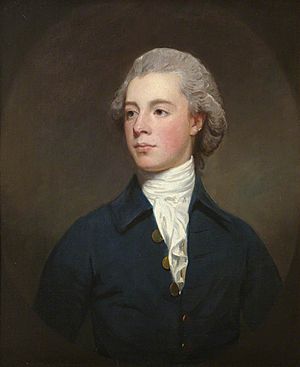Charles Philip Yorke facts for kids
Quick facts for kids
Charles Philip Yorke
FSA FRS
|
|
|---|---|

Portrait by George Romney
|
|
| Home Secretary | |
| In office 17 August 1803 – 12 May 1804 |
|
| Monarch | George III |
| Prime Minister | Henry Addington |
| Preceded by | Lord Pelham |
| Succeeded by | The Lord Hawkesbury |
| Member of Parliament for Cambridgeshire |
|
| In office 1790–1810 |
|
| Preceded by | Philip Yorke |
| Succeeded by | Lord Francis Osborne |
| Personal details | |
| Born | 12 March 1764 |
| Died | 13 March 1834 (aged 70) |
| Nationality | British |
| Political party | Tory |
| Spouse | Harriott Manningham |
Charles Philip Yorke (born March 12, 1764 – died March 13, 1834) was an important British politician. He served in several high-ranking government jobs. One of his most notable roles was being the Home Secretary from 1803 to 1804.
Contents
Charles Philip Yorke's Life in Politics
Charles Philip Yorke started his political journey as a Member of Parliament, often called an MP. An MP is a person elected to represent a specific area in the country's main law-making body, the House of Commons.
Representing Cambridgeshire
He represented the area of Cambridgeshire in Parliament. He was an MP for this region for a long time, from 1790 to 1810.
Military Service
Besides his political work, Yorke also served in the military. In 1793, he became an officer in the Cambridgeshire Militia. He was promoted to major in 1795. By 1806, he had become the colonel of this military group.
Later Parliamentary Roles
After his time representing Cambridgeshire, he later served as an MP for Liskeard. This was from 1812 to 1818.
Key Government Positions
In 1801, Charles Philip Yorke was appointed Secretary at War. This role was like a minister in charge of military affairs. He worked in the government led by Henry Addington.
In 1803, he moved to the Home Office and became the Home Secretary. The Home Secretary is a very important government minister. They are responsible for internal affairs, like law and order. During his time as Home Secretary, he held strong beliefs on religious policies.
In 1810, Yorke joined another government, led by Spencer Perceval. Here, he became the First Lord of the Admiralty. This position was in charge of the Royal Navy, Britain's powerful fleet of ships. He decided to retire from public life in 1818.
Joining the Royal Society
In 1801, Charles Philip Yorke was chosen to be a Fellow of the Royal Society. This is a very respected group for people who have made important discoveries in science.
Yorke's Family Life
Charles Philip Yorke came from an important family. He was the second son of Charles Yorke. His grandfather was Philip Yorke, 1st Earl of Hardwicke, a very influential figure. His mother was Agneta Johnstone.
His brother was Admiral Sir Joseph Sidney Yorke. Joseph was also a notable person, serving in the navy. Charles Philip Yorke's nephew later inherited the title of Earl of Hardwicke.
In July 1790, Charles Philip Yorke married Harriott Manningham. She was the oldest daughter of Charles Manningham. Charles and Harriott did not have any children together. Charles Philip Yorke passed away in March 1834, just one day after his 70th birthday.
He also had a son named Charles Eurwicke Douglas.
Legacy
Charles Philip Yorke's name lives on in a place far away. In 1802, a famous explorer named Matthew Flinders was exploring Australia. He named a large piece of land in South Australia the Yorke Peninsula. He did this to honor Charles Philip Yorke.

